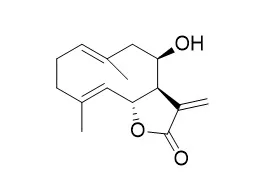| Description: |
Eupatolide has anti-inflammatory activity, it inhibits lipopolysaccharide-induced COX-2 and iNOS expression in RAW264.7 cells by inducing proteasomal degradation of TRAF6. It can suppress PDGF-induced proliferation and migration of VSMC through HO-1 induction via ROS-Nrf2 pathway and may be a potential HO-1 inducer for preventing or treating vascular diseases. Eupatolide exhibits potent cytotoxicity against HL-60, SMMC-7721, A-549, MCF-7, and SW-480 cancer cell lines, with IC50 values ranging from 1.57 to 22.58 uM; it sensitizes breast cancer cells to TRAIL through down-regulation of c-FLIP expression, it is a valuable compound to overcome TRAIL resistance in breast cancer cells. |
| In vitro: |
| Phytochemistry. 2016 Sep;129:68-76. | | Bioactive sesquiterpenoids from the flowers of Inula japonica.[Pubmed: 27452450] |
METHODS AND RESULTS:
Phytochemical investigation of the flowers of Inula japonica led to isolation of nine sesquiterpenoids, inujaponins A-I, as well as eighteen known ones. These sesquiterpenoids belong to six skeletal-types, including eudesmane, 1,10-seco-eudesmane, germacrane, guaiane, 4,5-seco-guaiane, and pseudoguaiane sesquiterpenoids. Their structures were established by extensive spectroscopic analysis. The absolute configurations of inujaponin A, Eupatolide, and deacetylovatifolin were determined by Cu-Kα X-ray crystallographic analysis.
CONCLUSIONS:
Most of the isolated compounds exhibited potent cytotoxicity against HL-60, SMMC-7721, A-549, MCF-7, and SW-480 cancer cell lines, with IC50 values ranging from 1.57 to 22.58 μM. Some selected compounds also possessed significant inhibitory activity against LPS-induced NO production in RAW264.7 macrophages with IC50 values ranging from 1.42 to 8.99 μM. | | Eur J Pharmacol. 2010 Jun 25;636(1-3):173-80. | | Eupatolide inhibits lipopolysaccharide-induced COX-2 and iNOS expression in RAW264.7 cells by inducing proteasomal degradation of TRAF6.[Pubmed: 20353767 ] | Inula britannica is a traditional medicinal plant used to treat bronchitis, digestive disorders, and inflammation in Eastern Asia.
METHODS AND RESULTS:
Here, we identified Eupatolide, a sesquiterpene lactone from I. britannica, as an inhibitor of cyclooxygenase-2 (COX-2) and inducible nitric oxide synthase (iNOS) expression. Eupatolide inhibited the production of nitric oxide (NO) and prostaglandin E(2) (PGE(2)) as well as iNOS and COX-2 protein expression in lipopolysaccharide (LPS)-stimulated RAW264.7 cells. Eupatolide dose-dependently decreased the mRNA levels and the promoter activities of COX-2 and iNOS in LPS-stimulated RAW264.7 cells. Moreover, Eupatolide significantly suppressed the LPS-induced expression of nuclear factor-kappa B (NF-kappaB) and activator protein-1 (AP-1) reporter genes. Pretreatment of Eupatolide inhibited LPS-induced phosphorylation and degradation of I kappaB alpha, and phosphorylation of RelA/p65 on Ser-536 as well as the activation of mitogen-activated protein kinases (MAPKs) and Akt in LPS-stimulated RAW264.7 cells. Eupatolide induced proteasomal degradation of tumor necrosis factor receptor-associated factor-6 (TRAF6), and subsequently inhibited LPS-induced TRAF6 polyubiquitination.
CONCLUSIONS:
These results suggest that Eupatolide blocks LPS-induced COX-2 and iNOS expression at the transcriptional level through inhibiting the signaling pathways such as NF-kappaB and MAPKs via proteasomal degradation of TRAF6. Taken together, Eupatolide may be a novel anti-inflammatory agent that induces proteasomal degradation of TRAF6, and a valuable compound for modulating inflammatory conditions. |
|






 Cell. 2018 Jan 11;172(1-2):249-261.e12. doi: 10.1016/j.cell.2017.12.019.IF=36.216(2019)
Cell. 2018 Jan 11;172(1-2):249-261.e12. doi: 10.1016/j.cell.2017.12.019.IF=36.216(2019) Cell Metab. 2020 Mar 3;31(3):534-548.e5. doi: 10.1016/j.cmet.2020.01.002.IF=22.415(2019)
Cell Metab. 2020 Mar 3;31(3):534-548.e5. doi: 10.1016/j.cmet.2020.01.002.IF=22.415(2019) Mol Cell. 2017 Nov 16;68(4):673-685.e6. doi: 10.1016/j.molcel.2017.10.022.IF=14.548(2019)
Mol Cell. 2017 Nov 16;68(4):673-685.e6. doi: 10.1016/j.molcel.2017.10.022.IF=14.548(2019)